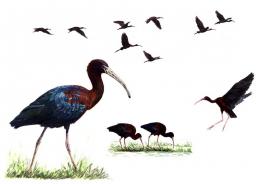Glossy Ibis - Plegadis falcinellus
The Glossy ibis belongs to the Ibis and Spoonbill family. It is easy recognizable on account of its shiny, iridescent dark plumage when seen at close quarters, and for its long curved bill.
It is a rather rare and threatened bird, with very few pairs nesting in our country: in Tuscany it especially occurs during migration and the summer months.
Although almost all the European population passes winter in tropical Africa, some individuals regularly winter in the Mediterranean area, including Italy.
The species does not always frequent the same nesting sites, alternating between colonising suitable new areas and suddenly disappearing: in the years 1999 and 2000-02 the species nested in the heronry at Fucecchio Marshes, varying between 6-12 pairs.
The nest is usually built on trees or shrubs, in pluri-specific colonies together with herons.
Its Italian name (Mignattaio) derives from “mignatte”, an old name for leech, which together with many other aquatic invertebrates makes up its diet.
When it feeds, the Glossy ibis continuously and rapidly probes the ground, pushing its beak deep into the substrate or mud, using a technique that strongly resembles those of several waders, like curlews.
The Glossy Ibis frequents ponds and marshes but also flooded fields and wet meadows, where it often feeds. A cosmopolitan species, the Glossy ibis is widespread over all the continents.




